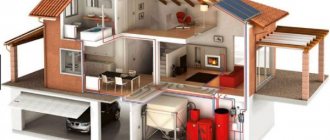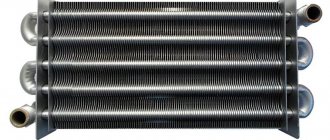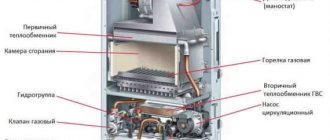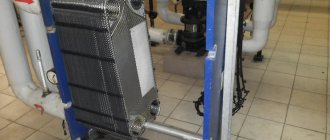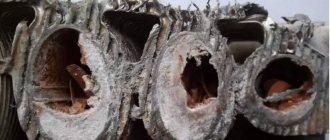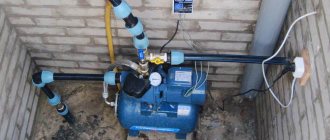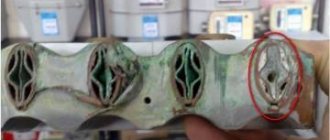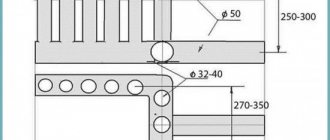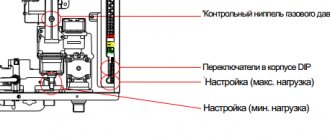An air heat exchanger is specialized equipment that is actively used both for various domestic purposes and in certain areas of industry. They are used for cooling various technical liquids, water, ventilation of rooms, cooling or heating air. In order to decide on the choice of an air heat exchanger, it is important to know what types of such equipment there are, what points to pay attention to when purchasing.
Design features and operating principle
Depending on the design features, there are several types of air heat exchangers:
- Tubular-ribbed.
- Smooth tube.
- Profile-plate.
In tube-fin heat exchangers, air is consumed from the environment to cool water. Due to its forced circulation, the temperature quickly decreases. If it is necessary to cool the oil, water is most often used as a coolant, which is cooled by fans.
Air heat exchanger materials and design
The efficiency of the heat exchanger depends on the material from which its main elements are made - plates or sections. The best thermal conductivity indicators are shown by copper and aluminum, which is why bimetallic structures are often used in air heat exchangers - copper tubes with aluminum fins.
The choice of heat exchanger material is influenced by the type of cooled medium and operating conditions. An aggressive environment can negatively affect the condition of the heat exchanger, so stainless steel heat exchangers are used to cool saline solutions, aggressive media and liquids with impurities.
Fans
Depending on the type of heat exchanger, axial, centrifugal or tangential fans are used in the design. Auxiliary structures (hull, supports, etc.) are usually made of galvanized steel.
Types of air heat exchangers
The main purpose of air heat exchangers is cooling or heating gases and liquids. The category of such equipment includes the following units:
- condensers, heaters;
- radiators, air coolers (industrial and household);
- evaporators, dry coolers;
- steam heaters, recuperators.
Such installations are used in various fields of industry. The main ones are metallurgy, energy, chemical industry, oil and gas industry, light industry. However, most often they are used for various household purposes (if we talk about certain types of such units, for example, an air heat exchanger for a chimney).
Depending on the working medium used, there are several types of air heat exchangers:
- Air-to-air. Most often, such units are used in the assembly of ventilation systems and the production of climate control equipment.
- Air-steam. Used for steam condensation. Such heat exchangers are used in the production of various steam generators.
- Air-liquid. For cooling in such units, an aqueous solution of propylene and ethylene glycol, ordinary water, or saline solution can be used. The coolant enters the sectional heat exchangers. A powerful air flow is directed at them, which is created by fans. Due to this, the temperature decreases significantly.
- Air-freon. Such air heat exchangers are used in the installation of air conditioning systems for apartments, private houses, industrial enterprises, and shopping centers. The operating principle of such units is based on the process of heat exchange between air and the liquid phase of the refrigerant. In this case, freon turns into an evaporator, and the air is cooled.
- Air-oil. Such heat exchangers are most often used in mechanical engineering and heavy industry. The oil lubricates the moving parts of the equipment, is discharged to the heat exchanger, in which its temperature is reduced to operating temperature, and it again enters the machine.
Thematic blogs
Any object and phenomenon can be viewed from different points of view, let’s designate at least three: • How is it done? Shape, material. • Why is this done? Performed tasks and specific conditions for using the heat exchanger. • How it works? Heat exchanger and physical principles inherent in its functionality Let's start visually with the third point - How does it work? The vessel contains a very hot tea drink that needs to be cooled. Note that there are three available methods - Contact heat exchangers 1. Blow on a hot liquid - we get contact heat exchange. Air, a gaseous medium, is in direct contact with the liquid medium of the drink. There is heat exchange, but not yet a heat exchanger. Cooling towers are full-fledged contact heat exchangers. Huge “pipes” in the shape of unusual barrels, which can be seen on the territory of thermal power plants, are giant contact heat exchangers. Hot water coming out of the turbine condenser is sprayed into them, and cooling is carried out by atmospheric air. Regenerative heat exchanger 2. You can place several chilled spoons in a cup - regenerative heat exchange will occur. Quite unusual, but clear. A regenerative heat exchanger is a heat exchanger on the surface of which the heating and heated media pass alternately. Another striking household example is the heater of a sauna stove. First, hot gases from the furnace heat special stones, and then the heat stored in them is regenerated when the water that was “added” to the heater evaporates, and regeneration is evident with a change in the state of aggregation (water turns into steam) or with a phase transition in other terminology .
Recuperative heat exchanger 3. If you put a cup of tea in a bowl of cold water, you get a recuperative heat exchanger-cooler. A “water bath,” when one liquid cannot be brought to a boil and is heated in a small container placed in a larger container, is a phenomenon of the same order.
Types of heat exchangers according to the movement of coolant and media. Moving on to point 2 ( Why is this done? ), we designate the media passing through the heat exchanger:
• water-to-water heat exchanger - shell-and-tube and plate heat exchangers for hot water supply and central heating systems, oil coolers in internal combustion engines, beverage coolers and much more;
• steam-water heat exchanger - various heaters of shell-and-tube design (steam in the shell, and liquid in the tube bundle). Sometimes they can also be contact ones, for example, the deaerator of a steam boiler is also a heat exchanger, where steam not only degasses the feed water, but also heats it up. (See Fig. 1);
• steam-steam heat exchanger – used to produce low-potential steam by heating from high-potential steam, for example in sterilizers. (See Fig.2);
• steam-gas heat exchanger; heat recovery from gas turbine exhaust. (See Fig. 3);
• gas-gas heat exchanger; condensation of gaseous media into the liquid phase or vice versa evaporation (See Fig. 4);
• gas-water heat exchanger is used in waste heat exchangers.
First point - How is this done? - requires a more detailed description. Heat exchangers differ in the state of aggregation of the heating and heated media . The media passing through the heat exchanger also have their own characteristics (viscosity, content of mechanical particles, the ability to burn on the walls, the need for sterilization, etc.). To organize the movement of coolants in the unit, see the figure below:
Scheme of movement of coolants (mediums)
Co-current flow is the movement of two coolants parallel to each other in the same direction. Counterflow is the movement of two coolants parallel to each other in opposite directions. Cross current is the movement of two coolants in mutually perpendicular directions. Mixed current - one or more coolants make several passes in the apparatus, washing part of the surface according to a direct flow pattern, and the other part according to a countercurrent or cross current pattern.
Based on the dynamics of aggregate (phase) states of heat-carrying media, heat exchangers are divided into devices: • without phase transitions (heaters, coolers);
• with a change in the state of aggregation of one of the coolants (evaporators, condensers);
• with a change in the state of both heat-carrying media (units with increased heat exchange intensity, including freezers, rectifiers, etc.).
Form and content Since our company is responsible for washing and cleaning all types of heat exchangers, we will dwell on this classification feature separately. According to their design characteristics, heat exchangers are divided into: shell-and-tube, plate, finned tubes, spiral, elemental (sectional), “pipe-in-pipe” and others. Let's consider the main ones:
Shell-and-tube heat exchanger Shell-and-tube heat exchanger properties and principle of operation A shell-and-tube heat exchanger consists of a tube bundle, a tube sheet, a shell-housing, covers and pipes supplying media. The ends of the pipes are secured to the tube sheets by flaring, welding and soldering. The tubes are fitted to two tube sheets by rolling or welding. The covers are removable and are designed for the inlet and outlet of the coolant that flows through the pipes. The interpipe and pipe space are separated. The second coolant is located in the interpipe space, which also has inlet and outlet pipes. Often, substances with solid inclusions flow through pipes. Shell and tube heat exchangers can have both vertical and horizontal designs. Functionally, they can differ in the same way that vertical differs from horizontal, for example, a chiller evaporator, where freon evaporating in tubes cools circulating water , or a hot water heat exchanger, where the network coolant heats up hot water.
shell-and-tube heat exchanger for hot water chiller
shell and tube evaporator heat exchanger
Disadvantages and advantages of shell-and-tube heat exchangers There is an opinion that shell-and-tube heat exchangers are “more durable” and more reliable than plate heat exchangers, but comparison of design types is the topic of another article. Note that in terms of maintenance (washing, cleaning and routine repairs), shell-and-tube devices require more qualifications, however, their service life is much longer.
Plate heat exchanger Collapsible plate heat exchanger Collapsible heat exchanger principle of operation Collapsible plate heat exchangers have intensive heat exchange (with timely cleaning), ease of manufacture, compactness, low hydraulic resistance, and ease of installation. These heat exchangers consist of individual plates separated by gaskets, two end chambers, a frame and tie bolts. The plates are stamped from thin sheet steel (thickness 0.7 mm). To increase the heat exchange surface and turbulize the coolant flow, the flow part of the plates is made corrugated or ribbed, and the fins can be horizontal or “herringbone” (corrugation pitch 11.5; 22.5; 30 mm; height 4 - 7 mm). Specially shaped gaskets are glued to the plates or inserted into the grooves to seal the structure; The coolant is directed either along the plate or through a hole into the next channel.
The movement of coolants in plate heat exchangers can be carried out in direct flow, counter flow or in a mixed pattern. The heat exchange surface of one device can vary from 1 to 160 m2, the number of plates - from 7 to 303. In plate heat exchangers, the coolant temperature is limited to 150 ° C (taking into account the properties of the gaskets), the pressure should not exceed 10 kgf/cm2.
Advantages and disadvantages of collapsible plate heat exchangers The advantages of this type of device include the intensity of the heat exchange process, compactness, and the ability to completely disassemble the unit for cleaning.
Disadvantages include the need for careful assembly to maintain tightness. In addition, the disadvantages of this design are the tendency to degradation of the materials from which the gaskets are made and the relatively low thermal resistance.
Brazed heat exchangers Brazed plate heat exchanger (non-separable) application Plate heat exchangers can be non-separable brazed and are in demand where pressure and temperature go beyond the limits of household “civil” ones - dryers of gases and technical liquids, condensers, coolers, etc.
Funke plate heat exchanger
Alfa Laval plate heat exchanger
Heat exchangers made of finned pipes Design, purpose and use of finned heat exchangers It is enough to open the hood of the car to see the radiator - a heat exchanger made of finned pipes, in the outdoor unit of the air conditioner and in the indoor unit, these heat exchangers also do a common job, but perform different functions, in the indoor unit the refrigerant evaporates, and in the outside - its condensation, simply put, its release into the atmosphere.
Many devices generate large amounts of waste heat, which is impractical to recover, that is, reused in processes. This heat is released into the atmosphere. For these purposes, various types of coolers are used. The design of finned tube coolers consists of a series of tubes within which the cooled liquid flows, and the presence of finned lamellas allows for a large area of heat dissipation.
The fins and cooler tubes are blown by fans. This type of cooler is used in cases where there is no possibility of drawing water for cooling purposes: for example, at the installation site of chemical plants. Finned heat exchangers are used in air coolers. And now, when everything seems to be in order with the form, let’s take a closer look at the content.
Most of the coolers, condensers, heating and cooling sections of ventilation units, in a word, heat exchangers made of finned tubes, have copper tubes finned with aluminum lamellas, but it’s no secret that the “COPPER and ALUMINUM” pair is galvanically aggressive:
table of galvanic compatibility of metals Why this rule is ignored by most manufacturers is a RHETORICAL QUESTION! However, how and why car owners, who are willing to pay for a reliable brass radiator that is repairable, are forced to buy disposable aluminum radiators.
Experience in servicing such heat exchangers as part of ventilation equipment shows that the slightest drop of condensate at the junction of a copper tube and an aluminum lamella increases the aggressiveness of galvanization many times over; if there were a lot of drops, then repairing such a heat exchanger is a waste of effort and consumables.
galvanic corrosion in the heat exchanger
Spiral heat exchanger Spiral heat exchanger principle of operation In spiral heat exchangers, the heating surface is formed by two thin metal shells, welded to the dividing wall (core) and rolled in the form of spirals. Rigidity, strength, and also for fixing the distance between the spirals are provided by spacer bosses, which are welded to the sheets on both sides. Spiral channels of rectangular cross-section are limited by end caps. Sealing of channels in spiral heat exchangers is carried out in various ways. As a rule, each channel is welded on one side and sealed with a flat gasket on the other. In this case, mixing of media is excluded, and if the gasket is leaking, only one of them can leak out. This sealing method makes the channels relatively easy to clean. If the gasket material is destroyed by one of the coolants, then one channel is welded on both sides (“blind” channel), and the other is sealed with a flat gasket. In this case, the “blind” channel is not accessible for mechanical cleaning.
Sealing with a flat gasket of both open (through) channels is used only in cases where the mixing of working media (in the event of a leak) is safe and does not cause damage to the coolants. Through channels can also be sealed, with more or less constant pressure in the channels, by spiral U-shaped collars pressed by internal pressure against the projections in the cover.
Elemental (sectional) heat exchanger Sectional heat exchanger - operating principle These heat exchangers consist of elements connected in series - sections. The combination of several elements with a small number of pipes corresponds to the principle of a multi-pass shell-and-tube apparatus operating on the most advantageous scheme - counterflow. Elemental heat exchangers are effective when coolants move at comparable speeds without changing their state of aggregation.
Application, advantages and disadvantages of sectional heat exchangers These heat exchangers are applicable at high pressure of working media. The absence of partitions reduces hydraulic resistance and reduces the degree of contamination of the interpipe space. However, compared to multi-pass shell-and-tube heat exchangers, elemental heat exchangers are less compact and more expensive, since they contain many additional elements - tube sheets, flange connections, compensators, etc. The heat exchange surface of one section of the elemental heat exchangers used is 0.75-30 m2, the number of tubes is from 4 up to 140.
The simplest type of sectional heat exchanger is the “pipe-in-pipe” design. Heat exchangers of this type consist of a number of links connected in series, each link representing two coaxial pipes.
Shell and tube heat exchanger pipe in pipe
heat exchanger design pipe in pipe
heat exchanger pipe in pipe At the end of the article, we note that the correct selection of a heat exchanger for specific tasks, environments and the parameters of these environments will ensure the correct heat exchange process in any field, be it hot heat supply or drying of technical gases.
Washing and cleaning of heat exchangers, chemical washing of heat exchangers, timely maintenance of heat exchangers is the key to their uninterrupted operation. Original article stem-com.ru/cleaning-heat-exchangers/heat-exchangers/heat-exchanger-classification-heat/
Advantages and disadvantages
Air heat exchangers have many strong characteristics and capabilities. Main advantages:
- Versatility in terms of application. For example, an air heat exchanger on a chimney pipe allows you to use the heat of hot exhaust gases to heat water, which will later be used for domestic needs. An air heat exchanger for ventilation allows not only to circulate air in rooms, but also to cool or heat it.
- High performance. Average efficiency reaches 92%.
- Safety of use. In modern air heat exchangers, all processes are controlled automatically. In cases of overheating or excessive load on the device, it turns off automatically.
- When using such units in heating systems, you can quickly warm up even large rooms.
- Due to the uniform distribution of heat, condensation does not form.
Among the shortcomings, it is important to note several points. Firstly, if you live in areas with polluted air (near roads, large enterprises), you will have to change filters very often so that the equipment works at maximum productivity and does not break down for a long time. Secondly, significant heat losses when heating large areas. Thirdly, if the fan breaks down, the device will completely stop generating heat, which is unacceptable in some situations.
Gas-air heat exchangers
In air heating systems, air can be heated in gas-air heat exchangers when the heat of gas combustion products is partially or completely transferred to cold air. When heat is transferred through the wall, the efficiency of direct-flow or recirculating gas-air heat exchangers is 70...90%, and when air is heated as a result of direct mixing with gas combustion products, the efficiency of mixing heat exchangers increases to 100%.
Gas-air radiant heating
Scheme of gas-air flows in the heat generator: 1 gas burner; 2 blow radial fans; 3 heat exchanger
In a gas-air heating system with radiators, the function of heating devices is performed by heat-radiating pipes laid in the upper zone (not lower than 5 m from the floor surface) of the room. A mixture of heated air and combustion products circulates inside a closed loop of heat-emitting pipes. Heat transfer from the surface of the pipes into the room occurs mainly by radiation (up to 60%).
A mixture of air and gas combustion products passes through the heat generator. The coolant cooled in the heating system to a temperature of 80...90° in the heat generator is divided into two streams. The main one is mixed with a new portion of gas combustion products. The gas is burned in a forced-air burner, which can operate with a variable air flow coefficient. Next, the heated mixture with a temperature of up to 340°C enters the heating system. Another part of the coolant in a volume equal to the volume of combustion products passes through a heat exchanger (HE) and is released into the atmosphere. In the technical unit, due to the heat of the coolant, the air is heated, taken from the room and directed to the burner for burning gas. At the same time, gas consumption is slightly reduced and the efficiency of the installation is increased (up to 96%).
Gas radiant heating
The heating devices in this heating system are infrared burners. It is most advisable to use a radiant heating system in large rooms with significant heat loss. It is especially effective when heating partially or completely open work areas (installation, assembly, open parking lots, etc.). The small size and weight of infrared burners make them convenient for placement in heated rooms. Their heat transfer surface area is almost 10 times smaller than the heating surface area of water heating devices. Gas radiant heating is also used in various agricultural and warehouse buildings.
An ejection type burner is used for low pressure gas with complete pre-mixing of gas and air. The gas leaving the nozzle sucks in the surrounding air in the amount necessary for complete combustion and mixes with it in the body mixture. The gas mixture after the mixer diffuser enters the distribution chamber of a relatively large volume. The flow rate of the mixture is significantly reduced, which ensures almost the same static pressure on the inner surface of the tiles. In this case, the gas-air mixture moves at approximately the same speed in all cylindrical firing channels and, therefore, creates torches of the same length.
When the burner is operating, the ceramic tiles are heated to a certain depth and heat the gas-air mixture in the fire channels. The gas-air mixture burns in a thin layer above the outer surface of the tiles, which is heated to approximately 850°C. The metal mesh located above the ceramic emitter, when the heater burner is operating, becomes an additional emitter itself and, in addition, serves as a combustion stabilizer, preventing flame separation.
Electric heating
With electric heating, the production of heat is associated with the conversion of electrical energy. According to the method of obtaining heat, electric heating can be with the direct conversion of electrical energy into heat and with the transformation of electricity into heat in heat pumps. Electric heating systems are divided into local, when electricity is converted into heat in heated rooms or in the immediate vicinity of them, and central, for example, with electric boilers.
ü Electric heating has the following advantages in comparison with other heating systems:
ü absence of combustion products and environmental pollution;
ü high efficiency;
ü simplicity and short installation time of electrical wiring and heating devices;
ü lower capital costs;
ü compactness of heating devices;
ü flexibility of regulation and ease of automation.
The disadvantages of electric heating include:
Ø low hygienic indicators of devices with open high-temperature heating elements;
Ø fire hazard;
Ø high selling price of electricity and its scarcity.
